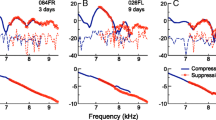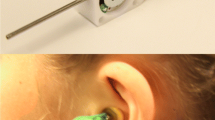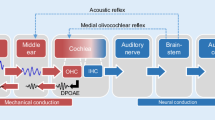Summary
Otoacoustic emissions (OAEs) evoked by clicks and tone bursts (TBs) were measured using a minor modification of the 1987 Bray and Kemp system in normal and hearing-impaired ears with high-frequency sensorineural hearing loss. Sixty ears of 60 subjects were tested. The average behavioral hearing threshold of 20 normally hearing ears was measured for the different “nonlinear” stimulus groups and defined as 0 dBnHL. Emissions were recorded in another 20 normally hearing ears and in 20 ears with steep high-frequency sensorineural hearing loss above 2 kHz. An unfiltered click of 80 μs duration and TBs at frequencies of 0.5, 1, 2, 3, 4, 5, and 6 kHz served as stimuli. The ears with high-frequency hearing loss were clearly distinguished from the normal ears in that emission energy decreased with higher frequency stimuli above 2 kHz. The mean slopes of the response-growth functions were significantly higher at lower audiometric thresholds. The normal ears showed a slope of 0.21–0.35dB/dBnHL above 2kHz while the slope of the pathological ears was 0.04–0.13 dB/dBnHL. These differences in TBOAEs could possibly be used clinically to carry out hearing tests that are more frequency-specific than those measuring solely click-evoked OAEs. Pathological ears had emissions in the lower frequency range, where they had a normal audiometric threshold. However, these emissions had significantly far lower amplitudes at frequencies around 0.5 and 1 kHz when compared to normal ears. This reduced emission energy may indicate a cochlear impairment of the pathological ears in frequency ranges where they still had normal audiometric thresholds.
Similar content being viewed by others
References
Bonfils P, Uziel A (1987) Recrutement of diplacousie — conception physiopathologique actuelle. Ann Otolaryngol Chir Cervico Fac 104:213–217
Bonfils P, Uziel A, Pujol R (1988) Evoked oto-acoustic emissions from adults and infants: clinical applications. Acta Otolaryngol (Stockh) 105:445–449
Bonfils P, Bertrand Y, Uziel A (1988) Evoked otoacoustic emissions: Normative data and presbyacusis. Audiology 27: 27–35
Bonfils P, Uziel A, Pujol R (1988) Evoked oto-acoustic emissions from adults and infants: clinical applications. Acta Otolaryngol (Stockh) 105:445–449
Bray P, Kemp D (1987) An advanced cochlear echo technique suitable for infant screening. Br J Audiol 21:191–204
Collet L, Gartner M, Moulin A, Kauffmann I, Disant F, Morgon A (1989) Evoked otoacoustic emissions and sensorineural hearing loss. Arch Otolaryngol Head Neck Surg 115:1060–1062
Elberling C, Parbo J, Johnsen NJ, Bagi P (1985) Evoked acoustic emissions: clinical application. Acta Otolaryngol [Suppl] (Stockh) 421:77–85
Grandori F (1983) Evoked oto-acoustic emissions stimulus-response relationships. Rev Laryngol Otol Rhinol (Bord) 104: 153–155
Harris FP, Glattke TJ (1988) Distortion-product emissions in humans with high-frequency sensorineural hearing loss. J Acoust Soc Am 84 [Suppl]: 74
Harris FP, Stagner BB, Martin GK, Lonsbury-Martin BL (1987) Effects of frequency separation of primary tones on the amplitude of acoustic distortion products. J Acoust Soc Am 82 [Suppl 1]:117
Harris FP, Lonsbury-Martin BL, Stagner BB, Coats AC, Martin GK (1989) Acoustic distortion products in humans: systematic changes in amplitudes as a function of f2/f1 ratio. J Acoust Soc Am 85:220–229
Hauser R, Probst R (1991) The influence of systematic primary tone level variation L2–L1 on the acoustic distortion product emission 2f1–f2 in normal human ears. J Acoust Soc Am 89: 280–286
Hauser R, Löhle E, Pedersen P (1989) Zur klinischen Anwendung click-evozierter otoakustischer Emissionen an der Freiburger HNO-Klinik. Laryngol Rhinol Otol (Stuttg) 68:661–666
Hauser R, Probst R, Harris FP (1991) Die klinische Anwendung otoakustischer Emissionen cochleärer Distorsionsprodukte. Laryngol Rhinol Otol (Stuttg) 70:123–131
Horner KC, Lenoir M, Bock GR (1985) Distorsion product otoacoustic emissions in hearing-impaired mutant mice. J Acoust Soc Am 78:1603–1611
Johnsen NJ, Elberling C (1982) Evoked acoustic emissions from the human ear. I. Equipment and response parameters. Scand Audiol 11:3–12
Johnsen NJ, Elberling C (1982) Evoked acoustic emissions from the human ear. II. Normative data in young adults and influence of posture. Scand Audiol 11:69–77
Kemp DT (1978) Stimulated acoustic emissions from within the human auditory system. J Acoust Soc Am 64:1386–1391
Kemp DT (1980) Towards a model for the origin of cochlear echoes. Hear Res 2:533–548
Kemp DT (1986) Otoacoustic emissions, travelling waves and cochlear mechanisms. Hear Res 22:95–104
Kemp DT (1988) Developments in cochlear mechanics and techniques for noninvasive evaluation. Adv Audiol 5:27–45
Lonsbury-Martin BL, Harris FP, Hawkins MD, Stagner BB, Martin GK (1990) Distortion product emissions in humans. I. Basic properties in normally hearing subjects. Ann Otol Rhinol Laryngol 99 [Suppl 147]:3–14
Norton SJ, Neely ST (1987) Tone-burst-evoked otoacoustic emissions from normal-hearing subjects. J Acoust Soc Am 81: 1860–1872
Probst R, Hauser R (1990) Distortion product otoacoustic emissions in normal and hearing-impaired ears. Am J Otolaryngol 11:236–243
Probst R, Coats AC, Martin GK, Lonsbury-Martin BL (1986) Spontaneous, click-, and toneburst-evoked otoacoustic emissions from normal ears. Hear Res 21:261–275
Probst R, Lonsbury-Martin BL, Martin GK, Coats A (1987) Otoacoustic emissions in ears with hearing loss. Am J Otolaryngol 8:73–81
Rutten WLC (1980) Latencies of stimulated acoustic emissions in normal human ears. In: Brink G van den, Bilsen FA (eds) Psychophysical, physiological, and behavioral studies in hearing. Delft University Press, Delft, pp 68–76
Schloth E (1982) Akustische Aussendungen des menschlichen Ohres (oto-akustische Emissionen). Dissertation, Technical University, Munich
Schmiedt RA (1986) Acoustic distortion in the ear canal. I. Cubic difference tones: effect of acute noise injury. J Acoust Soc Am 79:1481–1490
Wit HP, Ritsma RJ (1979) Stimulated acoustic emissions from the human ear. J Acoust Soc Am 66:911–913
Zwicker E (1983) Delayed evoked oto-acoustic emissions and their suppression by Gaussian-shaped pressure impulses. Hear Res 11:359–371
Author information
Authors and Affiliations
Additional information
Offprint requests to: R. Hauser
Rights and permissions
About this article
Cite this article
Hauser, R., Probst, R. & Löhle, E. Click- and tone-burst-evoked otoacoustic emissions in normally hearing ears and in ears with high-frequency sensorineural hearing loss. Eur Arch Otorhinolaryngol 248, 345–352 (1991). https://doi.org/10.1007/BF00169027
Received:
Accepted:
Issue Date:
DOI: https://doi.org/10.1007/BF00169027




